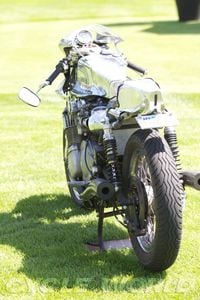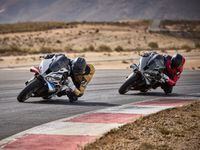This article was originally published in the 1995 October issue of Sport Rider.
The lap time came as a complete surprise: 1:32.8. Certainly not a 250cc Willow Springs lap record, but so far ahead of expectations it seemed as if the RATZ 250 had just won the world championship. The entire crew beamed with pleasure and James Parker looked like a Lotto winner. Despite minor setbacks during the RATZ’s first day in the real world, Parker’s latest brainchild was out of the crib and running.
James Parker, the designer of the RADD front suspension used on Yamaha’s GTS1000, returned to his roots with the RATZ, taking Yamaha’s potent TZ250 engine and building his version of what a race bike should be: thin, light, adjustable and designed with a purposefulness that makes the TZ250 donor bike look dull. Parker focused on frame rigidity and minimal frontal area, designing a Formula Two racer that incorporates not just the latest RADD (Rationally Advanced Design Development, owned by James Parker) front suspension concepts, but all the technology Parker thinks an F2 racebike needs. Willow Springs Raceway was rented for the RATZ’s maiden voyage and Sport Rider did the riding.
The engine, built by Extreme Lean’s Steve Biganski, is nothing more than a standard Yamaha product, capable of pumping out 82 horsepower at 12,400 rpm. But there the similarity ends and the extroverted bodywork, single-sided swingarms (front and rear) and razor-thin profile dominate your attention. It’s different, but different isn’t always better when you’re talking about race bikes. After all, the machines of Mick Doohan, Scott Russell and Loris Capirossi work pretty well, right? And since I race a ’95 Yamaha TZ250 at the national level, I came to Willow with more than a journalist’s interest. If this thing really worked, I’d steal it for the Elkhart Lake national!
Ergonomically Challenged
The first major hurdle was simply sitting on the bike. Parker's desire to cut frontal area meant tucking the handlebars inside the narrow fairing and my own "muscle memory" found the results quite curious. Obviously, the decreased leverage of the narrower bars would be unacceptable for a roadracer, but our initial tests would be slow and experimental. Parker knew the bar position would compromise steering leverage, but after all the work he did to reposition the radiator in the tailsection and cheat the wind up front, he couldn't bear to bolt on wide bars! The extreme narrowness of the bars was echoed by the seat and tank, giving the impression that our knees were touching. Few bikes can make a stock TZ feel fat: the RATZ does.
Biganski fired it up quickly, the V-Twin sounding sharp and bright. When the temp gauge came off the peg, I hopped on, clicked into gear and fed the clutch. At this point, everything felt quite normal, despite the fact that my hands were only inches apart and the seat was even less comfortable than a TZ’s hard pad. Exiting pit lane, I tentatively weaved back and forth in third gear, scrubbing the new Dunlop slicks and getting a feel for the bike beneath me. I could hear Parker holding his breath.
Lap One
The chassis felt too tall in front as I made my way around the first lap of the bike's life, though some of this was due to the handlebar position. The RATZ steered easily off center but wanted to hold its lean angle, and I found myself steering the bike out of a corner rather than bringing it upright with increasing throttle. The single front carbon-fiber rotor developed by C-Cat and mated to an AP caliper had little effect on the bike's velocity, a factor I hoped would improve as the brake bedded in and heated up. As the first lap ended, I returned to the pits for a once-over by the crew. It was certainly the slowest lap I'd taken at Willow Springs, but you can imagine the pressure not to be stupid. Better slow than sorry.
Richard Sims of Sims & Rohm helped James Parker and Jeff Karr check the bike and we discussed the bike’s first 2.5 miles. Parker’s excitement was palpable; he’d been working on this thing for two years and it had actually completed a lap under its own power only minutes after being started for the first time. Imagine his delight later in the day.
Gaining Momentum
I re-entered the racetrack after a thorough check and began experimenting. Push hard enough on the narrow bars and the bike would actually steer quickly, though it continued to lean unless arrested with outside bar pressure, an unnerving fall-in tendency especially noticeable in the slower corners. The carbon front brake improved marginally with a few laps, but never came close to working well, needing a healthy squeeze for minimal stopping; I suspect the master cylinder-to-caliper ratio was incorrect. Four laps into the test, the engine was getting broken in and the bike hadn't done anything silly or unexpected: no wobbles, head shakes or surprises. The pace had increased with each lap, and midway through the fifth lap I found the first problem as I banked right into turn nine. The front end pattered and skipped as I leaned over, pushing the bike wide at about 80 mph. I backed off the throttle to load the front end, took one more lap to confirm the problem and entered the pits with the bad news. Sims and Parker got the wrenches out.
The front wheel bearing spacer wasn’t properly sized and Parker surmised the looseness was translating into the chassis. He and Sims disassembled and adjusted the components, at the same time spotting some surface cracks in the front carbon brake disc. With the front end reassembled and a wary eye on the rotor, I returned to the track to test the fixes. Better, but the patter at full-right lean was still there. I suspected an unbalanced front tire, but everything was within spec.
The top-heaviness and fall-in tendencies I’d noticed since lap one were slowly dialed out by increasing rear ride height, loading the front tire and encouraging the bike to turn more neutrally. We continued to take preload out of the front spring, which augmented the increased rear ride height. Parker and Karr lengthened the handlebars to offer more steering leverage and things began clicking.
Decreasing front spring preload makes sense because we had set the bike with a standard amount of static sag, the same numbers I run on my TZ250. Obviously, spring preload on a forked bike must take into account weight transfer under braking. That means a relatively stiff spring because a race bike brakes extremely hard, yet must have some travel left to deal with bumps. We continued to back off our initial preload setting, as our testing showed that we hadn’t yet used all available travel; like the Britten and Bimota Tesi I’ve raced at Road Atlanta and Daytona, static sag numbers used when measuring a forked bike proved too stiff on the RATZ because braking forces aren’t eating up a huge amount of front suspension travel. By the end of the day, we had removed all the spring preload from the Penske front shock and found we could use a lighter spring.
I found myself surprised by the RATZ’s acceleration over turn six and out of turn one, even though my TZ puts out one or two more horsepower than this conservatively tuned mill. Though we had no numbers to prove it, Parker’s efforts at cheating the wind felt worthwhile to this rider because the V-twin seemed to labor less through the midrange and spin more freely on top…imagination? Perhaps. Unfortunately, improper jetting and a bad rear tire limited top speed to only 150 mph the next morning (a good stock TZ runs 154 mph), but plan on future numbers to back up my seat-of-the-leathers impression. On paper, Parker’s aerodynamic mods make sense and I think we’ll see proof of that when the RATZ returns.
Future RATZ Plans
Perfect? No, but for a first-time test we came away with some good information, a few uncovered flaws and a strong direction for the future. A more thorough check of the tires found the rear Dunlop out of round by 0.055 inch on the right side, which was exciting the chassis and feeding vibration into the front suspension's upper control arm (we had checked only the front tire earlier). This weak link prompted Parker to commission Sims & Rohm to build a titanium arm in one-inch stock to replace the 7⁄8-inch aluminum arm, though that decision had been made before the tire problem was uncovered. The enthusiastic Richard Sims will build the arm anyway; call him Mr. Titanium because Sims & Rohm provided endless amounts of trick fasteners, brackets and components to the RATZ project.
Penske’s attention has turned to revalving the shocks, increasing rebound in back and taking compression out of both ends while fitting the front unit with a lighter spring—minor changes considering the unique chassis. Parker has contacted Braking U.S.A. for a pair of ISR six-piston calipers and cast-iron rotors, both of which will mount to the left of the front upright and provide the type of braking a 250 needs. We like the lightness of the C-Cat carbon rotor, but the RATZ doesn’t need any extra experimental components and Parker wants a proven brake system, at least until the chassis is well-sorted and up to speed. Our testing pointed us toward raising the rear end and Parker will augment this trend by taking some ride height out of the front, a job that takes a bit more work than we had time for during our testing, but is an adjustment built into the chassis.
The crew felt an enormous sense of success from the RATZ’s first day of testing and, as a rider, I recognize the potential of the machine. A Formula Two pilot’s life is spent searching for more corner-entrance speed, and that’s exactly what Parker’s design should offer. Properly tuned, the RADD front suspension will deal with front tire traction only, rather than be split between tire traction and weight transfer under braking. The bad rear tire didn’t allow me to experiment with the kind of banzai cornering speeds common to the Formula Two world, so I’ll have to wait several months before resolving the all-important issues of front tire traction and feedback at the limit. James Parker has returned to Santa Fe to address the niggling problems uncovered during the RATZ’s maiden voyage. It will return soon—expectations are high.
James Parker never set out to become one of the world’s leading motorcycle suspension theorists, but that seems to be how things are turning out. An avid motorcyclist and formally trained designer, the 47-year-old Parker started serious suspension doodling in the late ’70s, and by 1982, he had an idea that eliminated the shortcomings he saw in the telescopic front fork. He formed RADD (Rationally Advanced Design Development) to market his patented system to manufacturers.
Over the years, Parker has built a series of prototypes to prove out his design. A modest four-stroke single created in ’84 earned Wayne Rainey’s blessing at a Willow Springs test session, and in ’87, a RADD FZ750–powered sport bike worked so well it led to Yamaha’s licensing of the technology for the ’93 GTS 1000 sport-tourer.
Parker’s goal now is to see his technology on front-line sport bikes and roadracers. That means convincing the uninitiated, and that’s what the RATZ is designed to do. This prototype is a pure racer (named for RADD and TZ250), powered by a Yamaha two-stroke twin. Compared with the older RADD design, the RATZ front suspension incorporates changes that better suit it to racing use. Its significant advantages include greater structural strength, improved suspension action and lighter weight.
Functionally, the RATZ front suspension is pretty simple. Two swingarms extend forward from the engine area and connect via ball joints to the upright. The ball joints allow for angular motion as the suspension moves over bumps, plus provide for steering. The front wheel bolts onto a short axle that is carried by bearings in the upright. Suspension loads are fed through the upright and lower arm to a Penske Racing shock. Steering is handled by a telescoping shaft that descends from the clip-ons directly to the top of the upright.
Packaging advantages inherent in the RATZ design result in roughly a 15 percent reduction in overall frontal area, which, with further development, could, in theory at least, make the RATZ as much as seven-mph faster than a fork-equipped TZ250. Racers have a name for that sort of thing. They call it free lunch. —Jeff Karr
Read more articles in the SR Archive.



















/cloudfront-us-east-1.images.arcpublishing.com/octane/AAN4TI76M5H5JMUVEIGASWXBDU.jpg)
/cloudfront-us-east-1.images.arcpublishing.com/octane/P3RXD2UCPFF37CMB7CHPVKXORY.jpg)
/cloudfront-us-east-1.images.arcpublishing.com/octane/VZEG2EJI2RDFZNHLRZMU56MD3Q.jpg)
/cloudfront-us-east-1.images.arcpublishing.com/octane/GVJQO5FFOFBWNGODOBRB4FBAW4.jpg)
/cloudfront-us-east-1.images.arcpublishing.com/octane/BIVAK2SFIBDJJM25E7I5VU2FJE.jpg)
/cloudfront-us-east-1.images.arcpublishing.com/octane/CH5VX52UG5CFHOVH5A6UYEFWWA.jpg)
/cloudfront-us-east-1.images.arcpublishing.com/octane/ZVGJNGZRU5C33N7KN23BBFKSC4.jpg)


/cloudfront-us-east-1.images.arcpublishing.com/octane/CZ5OM3E43ZEXJHY7LCYXCHLIKI.jpg)
/cloudfront-us-east-1.images.arcpublishing.com/octane/DF5T4K5KPZFJXFCTGPYR77PKJM.jpg)
/cloudfront-us-east-1.images.arcpublishing.com/octane/RMCT2KVQBJHBZMRTSLOVPMOILU.jpg)

/cloudfront-us-east-1.images.arcpublishing.com/octane/K45KB2XHQVA65DX7VN4ZSMT2BI.jpg)
/cloudfront-us-east-1.images.arcpublishing.com/octane/FNHXQQ56BRD7TO4YIJ453PNG2M.jpg)
/cloudfront-us-east-1.images.arcpublishing.com/octane/OIKJC4JA3ZH7BMKUGWYKBIY5FA.jpg)
/cloudfront-us-east-1.images.arcpublishing.com/octane/MT2SAEWY6FDXFBYSLDE3AEFDTM.jpg)
/cloudfront-us-east-1.images.arcpublishing.com/octane/66UPKPYVURBPRCP5HXSN56MEMM.jpg)
/cloudfront-us-east-1.images.arcpublishing.com/octane/EOREGDSRKFDCRJC6K3EDVHBGCE.jpg)
/cloudfront-us-east-1.images.arcpublishing.com/octane/42RF63Q3LVCMBP3DGTWXFYSMOA.jpg)
/cloudfront-us-east-1.images.arcpublishing.com/octane/XNVY3EVWZFCEVPUGJGAN633LXE.jpg)
/cloudfront-us-east-1.images.arcpublishing.com/octane/2PLTVHXY7FDSPFHKU5CFOC43ZY.jpg)
/cloudfront-us-east-1.images.arcpublishing.com/octane/B6M3WTRLFZGNXBEATNXPVGBBD4.jpg)
/cloudfront-us-east-1.images.arcpublishing.com/octane/4CMH3FI73BEM5D6MFYX42FLDSQ.jpg)